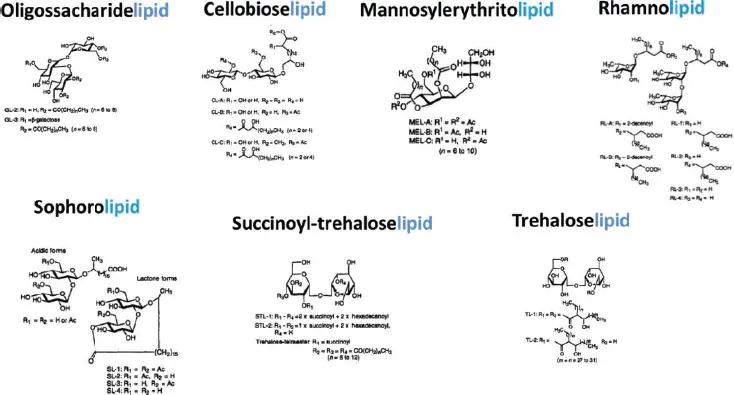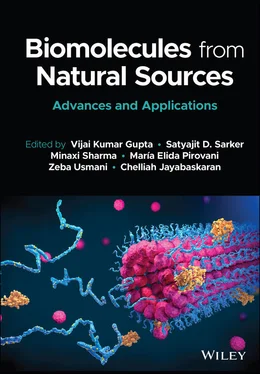Biomolecules from Natural Sources
Здесь есть возможность читать онлайн «Biomolecules from Natural Sources» — ознакомительный отрывок электронной книги совершенно бесплатно, а после прочтения отрывка купить полную версию. В некоторых случаях можно слушать аудио, скачать через торрент в формате fb2 и присутствует краткое содержание. Жанр: unrecognised, на английском языке. Описание произведения, (предисловие) а так же отзывы посетителей доступны на портале библиотеки ЛибКат.
- Название:Biomolecules from Natural Sources
- Автор:
- Жанр:
- Год:неизвестен
- ISBN:нет данных
- Рейтинг книги:5 / 5. Голосов: 1
-
Избранное:Добавить в избранное
- Отзывы:
-
Ваша оценка:
- 100
- 1
- 2
- 3
- 4
- 5
Biomolecules from Natural Sources: краткое содержание, описание и аннотация
Предлагаем к чтению аннотацию, описание, краткое содержание или предисловие (зависит от того, что написал сам автор книги «Biomolecules from Natural Sources»). Если вы не нашли необходимую информацию о книге — напишите в комментариях, мы постараемся отыскать её.
An up-to-date exploration of new and novel biomolecules Biomolecules from Natural Sources: Advances and Applications,
Biomolecules from Natural Sources: Advances and Applications
Natural Sources: Advances and Applications
Biomolecules from Natural Sources — читать онлайн ознакомительный отрывок
Ниже представлен текст книги, разбитый по страницам. Система сохранения места последней прочитанной страницы, позволяет с удобством читать онлайн бесплатно книгу «Biomolecules from Natural Sources», без необходимости каждый раз заново искать на чём Вы остановились. Поставьте закладку, и сможете в любой момент перейти на страницу, на которой закончили чтение.
Интервал:
Закладка:
Instituto de Lactología Industrial,
Universidad Nacional del Litoral, Santa Fe, Argentina
B. K. Yelikbayev
Kazakh National Agrarian University,
Almaty, Kazakhstan
1 Glycolipids
From Biosynthesis to Biological Activity toward Therapeutic Application Maria H. Ribeiro, Eva Fahr, and Sara Lopes
Research Institute for Medicines (iMed.ULisboa), Department of Pharmaceutical Sciences and Medicines, Faculty of Pharmacy, Universidade Lisboa, Lisbon, Portugal*Corresponding author: mhribeiro@ff.ulisboa.pt
1.1 Introduction
Biosurfactants are surface active biomolecules, mostly produced by microorganisms, with a wide range of industrial applications. Biosurfactants are usually designed with a hydrophilic moiety composed of amino acids or peptides, anions, or cations; mono-, di-, or polysaccharides; and a hydrophobic moiety consisting of unsaturated, saturated, or fatty acids (Banat et al. 2010).
Since biosurfactants are a wide group of biocompounds, there are different methods of classification. The most usual is classification according to the nature, chemical composition and microbial origin of the biosurfactants. They can be divided into five major categories: glycolipids, fatty acid/phospholipid, lipopeptide/lipoprotein, polymeric and surfactant particles (Cortés-Sánchez et al. 2013).
Among the biosurfactants, glycolipids have been intensively studied and are one of the most promising categories for commercial production and utilization (Warnecke and Heinz 2010). Glycolipids with one or two sugar residues attached to different lipid backbones can be found in cell membranes of bacteria, fungi, plants and animals in the form of sterylglycosides, glycosylceramides, and diacylglycerolglycosides (Warnecke and Heinz 2010). The most well-known glycolipids are sophorolipids (Bogaert et al. 2007; Oliveira et al. 2015), mannosylerythritol lipids (Im et al. 2001), rhamnolipids and trehalose lipids (Figure 1.1). The glycolipods that this chapter will focus on is a case study of trehalose lipids, also known as trehalolipids.

Figure 1.1 The chemical structures of the most common glycolipids.
The amphiphilic character triggers them to aggregate at liquid interfaces with different degrees of polarity and hydrogen bridges, giving them the ability to reduce surface- and interfacial-tension between solids, liquids and gases.
Furthermore most biosurfactants exhibit characteristics such as tolerance to pH, temperature and ionic strength, biodegradability, low toxicity, detergency, emulsification, de-emulsification and foaming. There is considerable interest in potential applications, due to their environmental friendly character and sustainability (Geys et al. 2014; Makkar et al. 2011; Santos et al. 2016; Smyth et al. 2010). Nowadays the preservation of the Earth as a sustainable planet is one of humanities greatest concerns. In line with this concern about the environment, many industries are changing to a global viewpoint on the future of manufacturing. In fact, they have recognized the potential of living cells in the pre-treatment of raw materials, processing operations, product modifications, selective waste management, energy recycling and conservation.
Biosurfactants are quite adaptable, their performance is versatile in a wide range of applications, in different areas, such as pharmaceutics, cosmetics, agronomy, food, beverages, metallurgy, agrochemicals, organic chemicals, petrochemicals, fertilizers, and others (Abdel-Mawgoud and Stephanopoulos 2018). The main applications in the pharmaceutical field are as anti-microbial, anti-cancer, anti-viral and anti-adhesive agents, immunological adjuvants, and in drug and gene delivery (Abdel-Mawgoud and Stephanopoulos 2018).
1.1.1 Application of Biosurfactants
The most commonly used surfactants are chemically produced from petroleum, these synthetic derived agents are generally toxic and not biodegradable. This problem motivates the search for more environmentally friendly surfactants, such as biosurfactants produced by microorganisms, which provides a wide range of applications (Santos et al. 2016; Vijayakumar and Saravanan 2015).
Biosurfactants have several advantages over petroleum based surfactants, such as structural diversity, low toxicity, greater biodegradability, the ability to function in wide ranges of pH, temperature and salinity, as well as greater selectivity, lower protein denaturing potency and lower critical micellar concentration (CMC). The wide range of industrial applications include the field of petroleum industry as well as bioremediation, agricultural, food processing, health, chemical, and cosmetic industries (Abdel-Mawgoud and Stephanopoulos 2018; Santos et al. 2016). The following sections present an overview of the most investigated application fields for biosurfactants.
1.1.1.1 Petroleum Industry
The major accruing market for biosurfactants is currently the petroleum industry, which offers different applications for them (Santos et al. 2016).
Petroleum, also known as crude oil is a natural energy source found beneath the earth´s surface. It is a resource that is in great demand, and has become the leading raw material for development and the economy in the past century. It basically consists of two to three phases (liquid/solid and gas), the industry uses several mechanisms to separate these (Almeida et al. 2016). Biosurfactants have shown promising applications in this industry, such as extraction, transportation or petrochemical manufacturing (Makkar et al. 2011).
Approximately 50–65% of oil residues are found in porous rocks, caused by high forces of capillarity, interfacial tension between the aqueous and the hydrocarbon phases and the high viscosity of the crude oil. These residues can often not be recovered by conventional oil recovery methods (Almeida et al. 2016; Santos et al. 2016). Biosurfactants can lower the interfacial tension between oil/rock and oil/water interfaces, in that way the oil-recovery can be enhanced. A mixture containing the producing microorganism can be injected into the porous rock, which will be sealed for a certain time to allow microbial growth. Therefore, the production of biosurfactants allows the breakdown of the oil film in the rocks and oil flow can be re-established. Experiments have shown that the use of indigenous microorganisms Arthobacter sp, Pseudomonas sp and Bacillus sp resulted in a reduction of paraffin from 29.8 to 25.5 % in 9 months (Bachmann et al. 2014).
Because of their amphipilic structure, biosurfactants have highly emulsifying properties which are important for the extraction of oil, to form stable water–oil emulsions (Bachmann et al. 2014).
1.1.1.2 Bioremediation
Oil spills during the transport, exploration or refining of petroleum products cause huge environmental hazards. The primary transportation method of oil products is via ship, which increases marine oil contamination due to the routine operations of ship washing, and accidents during exploration and transportation (Souza et al. 2014). Conventionally the spilled oil is removed via physicochemical methods, which doesn’t solve the problem in the long term, since the contaminants are simply removed from one environment to another, which often results in the development of even more toxic byproducts. For this reason, the search for biological alternatives, such as biosurfactants, is important to contribute to environmental health (Silva et al. 2014).
Читать дальшеИнтервал:
Закладка:
Похожие книги на «Biomolecules from Natural Sources»
Представляем Вашему вниманию похожие книги на «Biomolecules from Natural Sources» списком для выбора. Мы отобрали схожую по названию и смыслу литературу в надежде предоставить читателям больше вариантов отыскать новые, интересные, ещё непрочитанные произведения.
Обсуждение, отзывы о книге «Biomolecules from Natural Sources» и просто собственные мнения читателей. Оставьте ваши комментарии, напишите, что Вы думаете о произведении, его смысле или главных героях. Укажите что конкретно понравилось, а что нет, и почему Вы так считаете.


![Джеймс Купер - Пионеры, или У истоков Саскуиханны [The Pioneers, or The sources of the Susquehannah]](/books/395797/dzhejms-kuper-pionery-ili-u-istokov-saskuihanny-t-thumb.webp)









